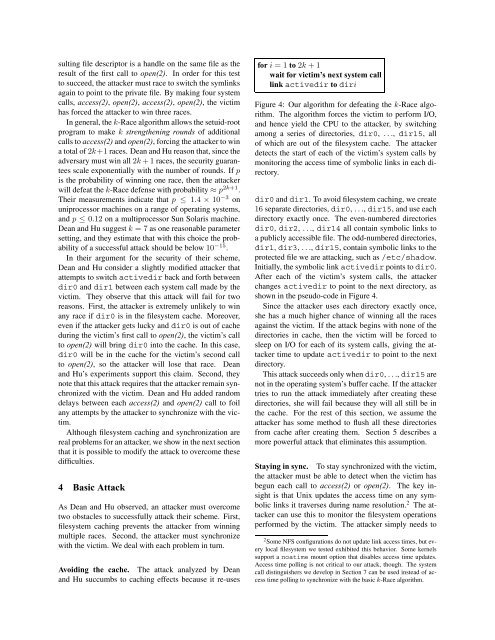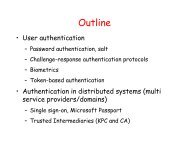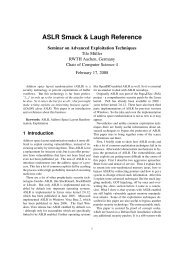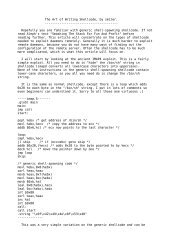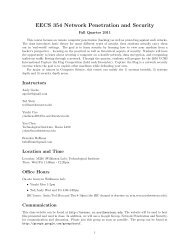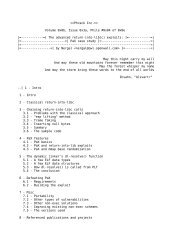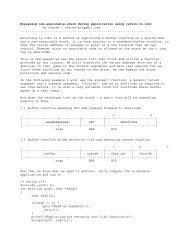Fixing Races for Fun and Profit: How to abuse atime - University of ...
Fixing Races for Fun and Profit: How to abuse atime - University of ...
Fixing Races for Fun and Profit: How to abuse atime - University of ...
You also want an ePaper? Increase the reach of your titles
YUMPU automatically turns print PDFs into web optimized ePapers that Google loves.
sulting file descrip<strong>to</strong>r is a h<strong>and</strong>le on the same file as the<br />
result <strong>of</strong> the first call <strong>to</strong> open(2). In order <strong>for</strong> this test<br />
<strong>to</strong> succeed, the attacker must race <strong>to</strong> switch the symlinks<br />
again <strong>to</strong> point <strong>to</strong> the private file. By making four system<br />
calls, access(2), open(2), access(2), open(2), the victim<br />
has <strong>for</strong>ced the attacker <strong>to</strong> win three races.<br />
In general, the k-Race algorithm allows the setuid-root<br />
program <strong>to</strong> make k strengthening rounds <strong>of</strong> additional<br />
calls <strong>to</strong> access(2) <strong>and</strong> open(2), <strong>for</strong>cing the attacker <strong>to</strong> win<br />
a <strong>to</strong>tal <strong>of</strong> 2k+1 races. Dean <strong>and</strong> Hu reason that, since the<br />
adversary must win all 2k + 1 races, the security guarantees<br />
scale exponentially with the number <strong>of</strong> rounds. If p<br />
is the probability <strong>of</strong> winning one race, then the attacker<br />
will defeat the k-Race defense with probability ≈ p 2k+1 .<br />
Their measurements indicate that p ≤ 1.4 × 10 −3 on<br />
uniprocessor machines on a range <strong>of</strong> operating systems,<br />
<strong>and</strong> p ≤ 0.12 on a multiprocessor Sun Solaris machine.<br />
Dean <strong>and</strong> Hu suggest k = 7 as one reasonable parameter<br />
setting, <strong>and</strong> they estimate that with this choice the probability<br />
<strong>of</strong> a successful attack should be below 10 −15 .<br />
In their argument <strong>for</strong> the security <strong>of</strong> their scheme,<br />
Dean <strong>and</strong> Hu consider a slightly modified attacker that<br />
attempts <strong>to</strong> switch activedir back <strong>and</strong> <strong>for</strong>th between<br />
dir0 <strong>and</strong> dir1 between each system call made by the<br />
victim. They observe that this attack will fail <strong>for</strong> two<br />
reasons. First, the attacker is extremely unlikely <strong>to</strong> win<br />
any race if dir0 is in the filesystem cache. Moreover,<br />
even if the attacker gets lucky <strong>and</strong> dir0 is out <strong>of</strong> cache<br />
during the victim’s first call <strong>to</strong> open(2), the victim’s call<br />
<strong>to</strong> open(2) will bring dir0 in<strong>to</strong> the cache. In this case,<br />
dir0 will be in the cache <strong>for</strong> the victim’s second call<br />
<strong>to</strong> open(2), so the attacker will lose that race. Dean<br />
<strong>and</strong> Hu’s experiments support this claim. Second, they<br />
note that this attack requires that the attacker remain synchronized<br />
with the victim. Dean <strong>and</strong> Hu added r<strong>and</strong>om<br />
delays between each access(2) <strong>and</strong> open(2) call <strong>to</strong> foil<br />
any attempts by the attacker <strong>to</strong> synchronize with the victim.<br />
Although filesystem caching <strong>and</strong> synchronization are<br />
real problems <strong>for</strong> an attacker, we show in the next section<br />
that it is possible <strong>to</strong> modify the attack <strong>to</strong> overcome these<br />
difficulties.<br />
4 Basic Attack<br />
As Dean <strong>and</strong> Hu observed, an attacker must overcome<br />
two obstacles <strong>to</strong> successfully attack their scheme. First,<br />
filesystem caching prevents the attacker from winning<br />
multiple races. Second, the attacker must synchronize<br />
with the victim. We deal with each problem in turn.<br />
Avoiding the cache. The attack analyzed by Dean<br />
<strong>and</strong> Hu succumbs <strong>to</strong> caching effects because it re-uses<br />
<strong>for</strong> i = 1 <strong>to</strong> 2k + 1<br />
wait <strong>for</strong> victim’s next system call<br />
link activedir <strong>to</strong> diri<br />
Figure 4: Our algorithm <strong>for</strong> defeating the k-Race algorithm.<br />
The algorithm <strong>for</strong>ces the victim <strong>to</strong> per<strong>for</strong>m I/O,<br />
<strong>and</strong> hence yield the CPU <strong>to</strong> the attacker, by switching<br />
among a series <strong>of</strong> direc<strong>to</strong>ries, dir0, . . ., dir15, all<br />
<strong>of</strong> which are out <strong>of</strong> the filesystem cache. The attacker<br />
detects the start <strong>of</strong> each <strong>of</strong> the victim’s system calls by<br />
moni<strong>to</strong>ring the access time <strong>of</strong> symbolic links in each direc<strong>to</strong>ry.<br />
dir0 <strong>and</strong> dir1. To avoid filesystem caching, we create<br />
16 separate direc<strong>to</strong>ries, dir0, . . ., dir15, <strong>and</strong> use each<br />
direc<strong>to</strong>ry exactly once. The even-numbered direc<strong>to</strong>ries<br />
dir0, dir2, . . ., dir14 all contain symbolic links <strong>to</strong><br />
a publicly accessible file. The odd-numbered direc<strong>to</strong>ries,<br />
dir1, dir3, . . ., dir15, contain symbolic links <strong>to</strong> the<br />
protected file we are attacking, such as /etc/shadow.<br />
Initially, the symbolic link activedir points <strong>to</strong> dir0.<br />
After each <strong>of</strong> the victim’s system calls, the attacker<br />
changes activedir <strong>to</strong> point <strong>to</strong> the next direc<strong>to</strong>ry, as<br />
shown in the pseudo-code in Figure 4.<br />
Since the attacker uses each direc<strong>to</strong>ry exactly once,<br />
she has a much higher chance <strong>of</strong> winning all the races<br />
against the victim. If the attack begins with none <strong>of</strong> the<br />
direc<strong>to</strong>ries in cache, then the victim will be <strong>for</strong>ced <strong>to</strong><br />
sleep on I/O <strong>for</strong> each <strong>of</strong> its system calls, giving the attacker<br />
time <strong>to</strong> update activedir <strong>to</strong> point <strong>to</strong> the next<br />
direc<strong>to</strong>ry.<br />
This attack succeeds only when dir0, . . ., dir15 are<br />
not in the operating system’s buffer cache. If the attacker<br />
tries <strong>to</strong> run the attack immediately after creating these<br />
direc<strong>to</strong>ries, she will fail because they will all still be in<br />
the cache. For the rest <strong>of</strong> this section, we assume the<br />
attacker has some method <strong>to</strong> flush all these direc<strong>to</strong>ries<br />
from cache after creating them. Section 5 describes a<br />
more powerful attack that eliminates this assumption.<br />
Staying in sync. To stay synchronized with the victim,<br />
the attacker must be able <strong>to</strong> detect when the victim has<br />
begun each call <strong>to</strong> access(2) or open(2). The key insight<br />
is that Unix updates the access time on any symbolic<br />
links it traverses during name resolution. 2 The attacker<br />
can use this <strong>to</strong> moni<strong>to</strong>r the filesystem operations<br />
per<strong>for</strong>med by the victim. The attacker simply needs <strong>to</strong><br />
2 Some NFS configurations do not update link access times, but every<br />
local filesystem we tested exhibited this behavior. Some kernels<br />
support a no<strong>atime</strong> mount option that disables access time updates.<br />
Access time polling is not critical <strong>to</strong> our attack, though. The system<br />
call distinguishers we develop in Section 7 can be used instead <strong>of</strong> access<br />
time polling <strong>to</strong> synchronize with the basic k-Race algorithm.


